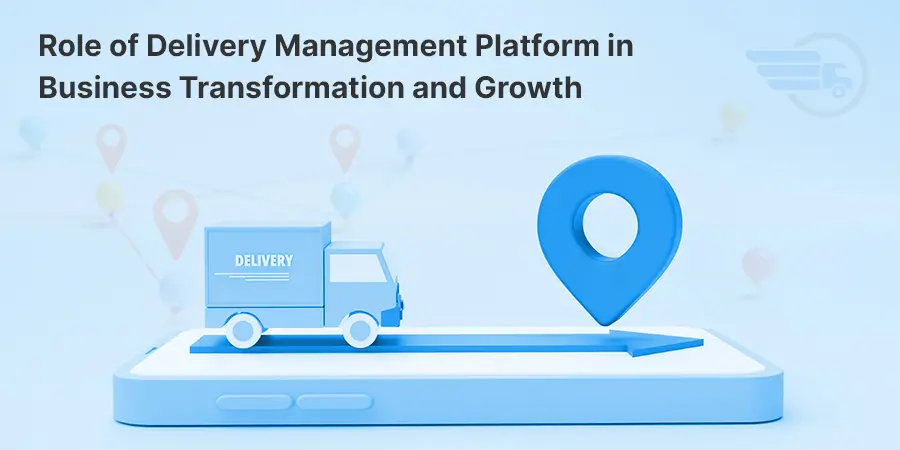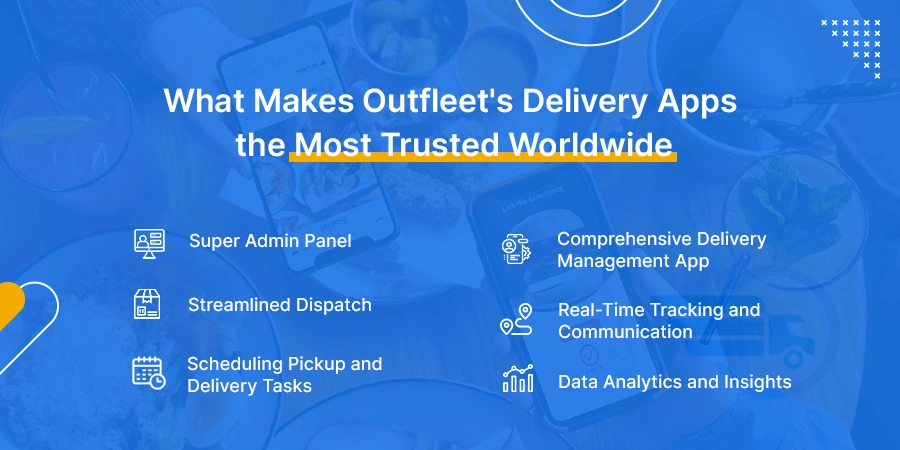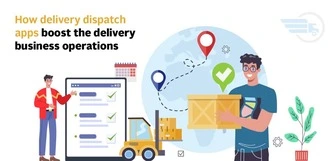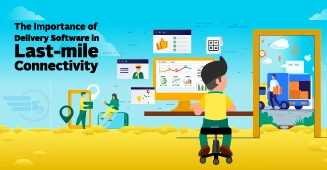Role of Delivery Management Platform in Business Transformation and Growth

A Delivery management platform is a software solution that helps businesses manage their delivery operations. It can help with everything from order tracking to route optimization to customer communication.
There are many benefits to using a delivery management platform. Here are just a few:
Delivery Management Platforms Efficiency and cost savings
The platform can help businesses streamline their delivery operations, which can lead to significant efficiency gains and cost savings. Here are some of the metrics that it can track to measure the efficiency of delivery operations:
Average delivery time: This metric measures the average amount of time it takes to deliver an order. A shorter average delivery time indicates that a business is more efficient in its delivery operations.
Number of late deliveries: This metric measures the number of deliveries that are not delivered on time. A high number of late deliveries indicates that a business needs to improve its delivery operations.
Cost per delivery: This metric measures the average cost of delivering an order. A lower cost per delivery indicates that a business is more efficient in its delivery operations.
Customer satisfaction: This metric measures the satisfaction of customers with the delivery process. A high level of customer satisfaction indicates that a business is providing a good level of service.
Competitiveness
In today's competitive marketplace, businesses need to be able to deliver their products and services quickly and efficiently. It can help businesses do this, which can give them a competitive edge. For example, the software can help businesses track the status of orders in real time, so they can proactively communicate with customers about any delays. Additionally, a platform can help businesses provide customers with real-time tracking information, which can help customers track the progress of their orders and know when to expect delivery.
Real-time visibility: Provide businesses with real-time visibility into their delivery operations. This means that businesses can track the status of orders in real time, so they can proactively communicate with customers about any delays. This can help businesses avoid customer dissatisfaction and improve their reputation.
Customer satisfaction: Helps businesses provide customers with real-time tracking information. This means that customers can track the progress of their orders and know when to expect delivery. This can help businesses improve customer satisfaction and loyalty.
Increased efficiency: Help businesses streamline their delivery operations. This can lead to increased efficiency and reduced costs.
Enhanced communication: Improves communication with their customers. This can be done by providing customers with real-time tracking information and by allowing customers to track the status of their orders online.
Improved decision-making: Can help businesses make better decisions about their delivery operations. This can be done by providing businesses with insights into their delivery data.
Operational Transparency
Operational transparency can help businesses improve their delivery operations in a number of ways. By providing businesses with real-time visibility into their delivery operations, data collection, problem identification, corrective action, and improved decision-making, a delivery management platform can help businesses improve their efficiency, reduce costs, improve customer satisfaction, and grow their business.
Real-time visibility: Delivery management software provides businesses with real-time visibility into their delivery operations. This means that businesses can see the status of orders at any time, so they can identify any potential problems and take corrective action as needed. This can help businesses avoid customer dissatisfaction and improve their reputation.
Data collection: Data can be used to identify areas for improvement and make changes to improve performance. For example, businesses can use the data to track the delivery time, the number of late deliveries, and the cost per delivery. This information can be used to identify areas where businesses can improve their delivery operations.
Problem identification: A delivery management platform can help businesses identify any potential problems with their delivery operations. For example, if a business sees that the delivery time is increasing, it can investigate the reasons for this and make changes to its delivery operations to improve the time it takes to deliver orders.
Corrective action: Take corrective action to address any problems with their delivery operations. For example, if a business sees that there are a high number of late deliveries, it can investigate the reasons for this and make changes to its delivery operations to improve on-time delivery.
Resource Optimization
Resource optimization can help businesses save money and improve their environmental impact in a number of ways. By optimising their use of vehicles, routes, load consolidation, and driver scheduling, businesses can reduce the amount of fuel they use, improve emissions, and save money.
Vehicle optimization:Optimise their use of vehicles by tracking the utilisation of vehicles and drivers. This can help businesses identify any underutilised vehicles or drivers, so they can be redeployed to more efficient routes.
Route optimization: Optimise their routes by taking into account factors such as traffic, weather, and delivery windows. This can help businesses reduce the distance travelled by their vehicles, which can save fuel and improve emissions.
Load consolidation: Consolidate deliveries by grouping orders that are going to the same area. This can help businesses reduce the number of vehicles they need to use, which can save fuel and improve emissions.
Driver scheduling: Schedule drivers more efficiently by taking into account factors such as driver availability, delivery windows, and distance travelled. This can help businesses reduce the number of hours that drivers work, which can improve driver satisfaction and reduce costs.
Scalability and Growth
Scalability and growth features can help businesses scale their delivery operations as they grow. This is because a platform can be easily customised to meet the specific needs of a business. For example, a platform can be configured to handle different types of deliveries, such as B2B, B2C, and last-mile deliveries. Additionally, a platform can be integrated with other business systems, such as CRM and ERP systems, which can help businesses streamline their operations.
Customization: Customise the specific needs of a business. This means that businesses can configure the platform to handle different types of deliveries, such as B2B, B2C, and last-mile deliveries. Additionally, businesses can integrate the platform with other business systems, such as CRM and ERP systems. This can help businesses streamline their operations and improve efficiency.
Scalability: A delivery management platform can be scaled to meet the growing needs of a business. This means that businesses can add more users, vehicles, and drivers to the platform as their needs grow. Additionally, businesses can add new features and functionality to the platform as needed.
Growth: Help businesses grow by providing them with the tools they need to manage their delivery operations more effectively. This can lead to improved efficiency, reduced costs, and improved customer satisfaction.
Measuring Delivery Efficiency
Measuring the efficiency of delivery operations is an important part of ensuring that a business is providing a good level of service to its customers. By collecting data and using it to identify areas for improvement, a business can make changes to improve its performance and achieve its goals.
Average delivery time: The average delivery time is the average amount of time it takes to deliver an order. This metric can be used to track the efficiency of a business's delivery operations over time. For example, if the average delivery time is increasing, it may indicate that there are problems with the delivery process that need to be addressed.
Number of late deliveries: The number of late deliveries is the number of orders that are not delivered on time. This metric can be used to track the accuracy of a business's delivery process. For example, if the number of late deliveries is increasing, it may indicate that there are problems with the delivery process that need to be addressed.
Cost per delivery: The cost per delivery is the average cost of delivering an order. This metric can be used to track the efficiency of a business's delivery operations from a financial perspective. For example, if the cost per delivery is increasing, it may indicate that there are problems with the delivery process that need to be addressed.
Conclusion
Overall, delivery management platforms can be a valuable tool for businesses of all sizes. They can help businesses improve their delivery operations, reduce costs, improve customer satisfaction, and scale their operations as they grow.
Latest Posts
- Transforming E-commerce: How Seamless Order Management Enhances Customer Experience
- Fast Track Optimization: The Art and Science of the Most Efficient Route Planner
- Mastering Efficiency: The Role of Real-time Tracking Solutions in Restaurant Business
- The Future of Delivery: How Streamlined Logistics Can Transform Your Operations
- Real-time Handling: Key to Solving Dispatch Delivery Problems
- The Powerful Impact of Grocery Delivery Management System on Retail Business
- Benefits of an Automated Dispatch Software for your Business
- Six Essential Task-handling Features in Delivery Tracking System Software
- 8 Reasons to Implement Software-based Dispatch Management in this Era
- Reengineering Urban Mobility: Unveiling the Power of Dispatch Delivery Management System



